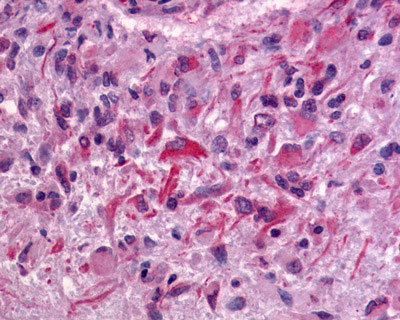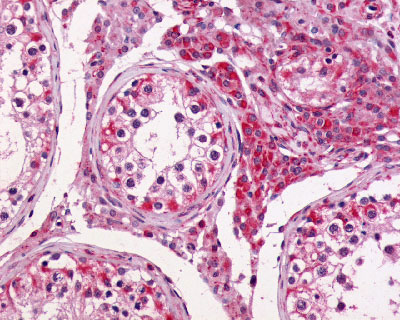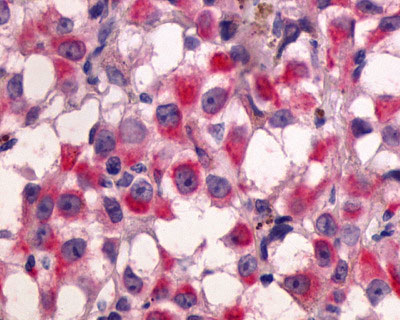ADGRG2 / GPR64 Antibody (C-Terminus)
Rabbit Polyclonal Antibody
- SPECIFICATION
- CITATIONS
- PROTOCOLS
- BACKGROUND

Application
| IHC-P |
|---|---|
| Primary Accession | Q8IZP9 |
| Reactivity | Human, Mouse, Hamster, Monkey |
| Host | Rabbit |
| Clonality | Polyclonal |
| Calculated MW | 112kDa |
| Dilution | IHC-P (5 µg/ml) |
| Gene ID | 10149 |
|---|---|
| Other Names | G-protein coupled receptor 64, Human epididymis-specific protein 6, He6, GPR64, HE6, TM7LN2 |
| Target/Specificity | Human GPR64. BLAST analysis of the peptide immunogen showed no homology with other human proteins. |
| Reconstitution & Storage | Long term: -70°C; Short term: +4°C |
| Precautions | ADGRG2 / GPR64 Antibody (C-Terminus) is for research use only and not for use in diagnostic or therapeutic procedures. |
| Name | ADGRG2 {ECO:0000303|PubMed:25713288, ECO:0000312|HGNC:HGNC:4516} |
|---|---|
| Function | Adhesion G-protein coupled receptor (aGPCR) for steroid hormones, such as dehydroepiandrosterone (DHEA; also named 3beta- hydroxyandrost-5-en-17-one) and androstenedione (PubMed:29393851, PubMed:35982227, PubMed:39884271). Involved in a signal transduction pathway controlling epididymal function and male fertility (PubMed:29393851). Ligand binding causes a conformation change that triggers signaling via guanine nucleotide-binding proteins (G proteins) and modulates the activity of downstream effectors, such as adenylate cyclase (PubMed:33303626, PubMed:34234254). ADGRG2 is coupled to G(s) G proteins and mediates activation of adenylate cyclase activity (PubMed:29393851, PubMed:34234254). Also able to couple with G(q) G proteins in vitro (PubMed:29393851). Together with CFTR, required to promote fluid reabsorption within efferent ductule (PubMed:29393851). |
| Cellular Location | Apical cell membrane; Multi-pass membrane protein |
| Tissue Location | Epididymis-specific expression (at protein level). Both subunits are associated with apical membranes of efferent ductule and proximal epididymal duct epithelia. Mainly expressed in the nonciliated principal cells of the proximal excurrent ducts Specifically over-expressed in Ewing sarcomas but also up-regulated in a number of carcinomas derived from prostate, kidney or lung |
| Volume | 50 µl |

Thousands of laboratories across the world have published research that depended on the performance of antibodies from Abcepta to advance their research. Check out links to articles that cite our products in major peer-reviewed journals, organized by research category.
info@abcepta.com, and receive a free "I Love Antibodies" mug.
Provided below are standard protocols that you may find useful for product applications.
Background
Could be involved in a signal transduction pathway controlling epididymal function and male fertility.
References
Osterhoff C.,et al.DNA Cell Biol. 16:379-389(1997).
Obermann H.,et al.Mol. Reprod. Dev. 64:13-26(2003).
Ross M.T.,et al.Nature 434:325-337(2005).
Dephoure N.,et al.Proc. Natl. Acad. Sci. U.S.A. 105:10762-10767(2008).
Olsen J.V.,et al.Sci. Signal. 3:RA3-RA3(2010).
If you have used an Abcepta product and would like to share how it has performed, please click on the "Submit Review" button and provide the requested information. Our staff will examine and post your review and contact you if needed.
If you have any additional inquiries please email technical services at tech@abcepta.com.













 Foundational characteristics of cancer include proliferation, angiogenesis, migration, evasion of apoptosis, and cellular immortality. Find key markers for these cellular processes and antibodies to detect them.
Foundational characteristics of cancer include proliferation, angiogenesis, migration, evasion of apoptosis, and cellular immortality. Find key markers for these cellular processes and antibodies to detect them. The SUMOplot™ Analysis Program predicts and scores sumoylation sites in your protein. SUMOylation is a post-translational modification involved in various cellular processes, such as nuclear-cytosolic transport, transcriptional regulation, apoptosis, protein stability, response to stress, and progression through the cell cycle.
The SUMOplot™ Analysis Program predicts and scores sumoylation sites in your protein. SUMOylation is a post-translational modification involved in various cellular processes, such as nuclear-cytosolic transport, transcriptional regulation, apoptosis, protein stability, response to stress, and progression through the cell cycle. The Autophagy Receptor Motif Plotter predicts and scores autophagy receptor binding sites in your protein. Identifying proteins connected to this pathway is critical to understanding the role of autophagy in physiological as well as pathological processes such as development, differentiation, neurodegenerative diseases, stress, infection, and cancer.
The Autophagy Receptor Motif Plotter predicts and scores autophagy receptor binding sites in your protein. Identifying proteins connected to this pathway is critical to understanding the role of autophagy in physiological as well as pathological processes such as development, differentiation, neurodegenerative diseases, stress, infection, and cancer.




